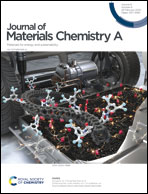Ab initio prediction of two-dimensional Si3C enabling high specific capacity as an anode material for Li/Na/K-ion batteries†
Abstract
Anode materials that possess similar electronic structures but larger lattice parameters in comparison with graphene usually show higher theoretical specific capacities for Li/Na/K-ion batteries. Herein, density functional theory (DFT) calculations are applied to evaluate the working performances of a two-dimensional Si3C monolayer with larger bond lengths than graphene. The negative adsorption energies of Li/Na/K atoms on the surface of the Si3C monolayer avoid the appearance of dendrites. With the intercalation of Li/Na/K atoms, the Si3C monolayer exhibits a puckered structure instead of its initial planar structure, lowering the diffusion energy barrier of Li/Na/K atoms. The theoretical specific capacities for Li, Na and K-ion batteries are estimated to be as high as 1394, 1115 and 836 mA h g−1, corresponding to the stoichiometries of Li5Si3C, Na4Si3C and K3Si3C, respectively. The average open circuit voltages (OCVs) for Li/Na/K-ion batteries are 0.58 V, 0.50 V and 0.71 V, respectively. The density of states (DOS) calculation reveals that the Si3C monolayer is semimetallic and its electronic conductivity can be enhanced by the intercalation of alkali metal atoms. In Li, Na and K-ion batteries, it is found that the maximum variations of lattice parameters of the Si3C monolayer are 3.54%, 2.69% and 2.24%, respectively. All the desirable properties indicate that the Si3C monolayer is a promising anode material for Li/Na/K-ion batteries. It also suggests that silicene doped with moderate carbon or some other elements is a potential anode material for alkali metal-based batteries.



 Please wait while we load your content...
Please wait while we load your content...